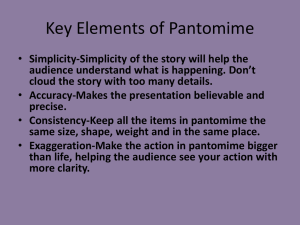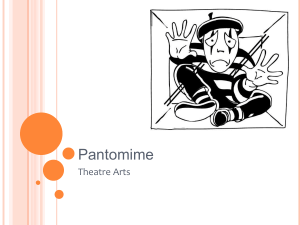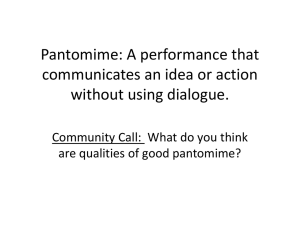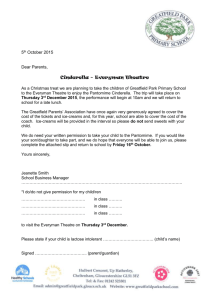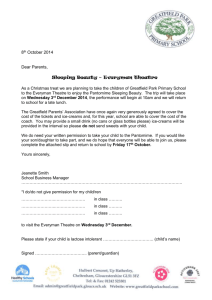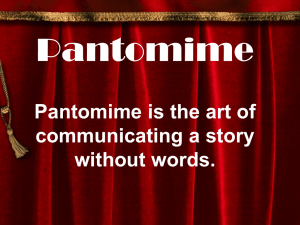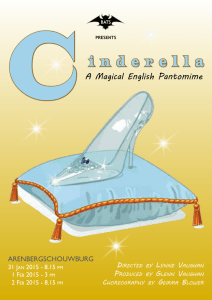Non-Verbal Communication.Pantomime Unit Lessons.Ellen Williams
advertisement
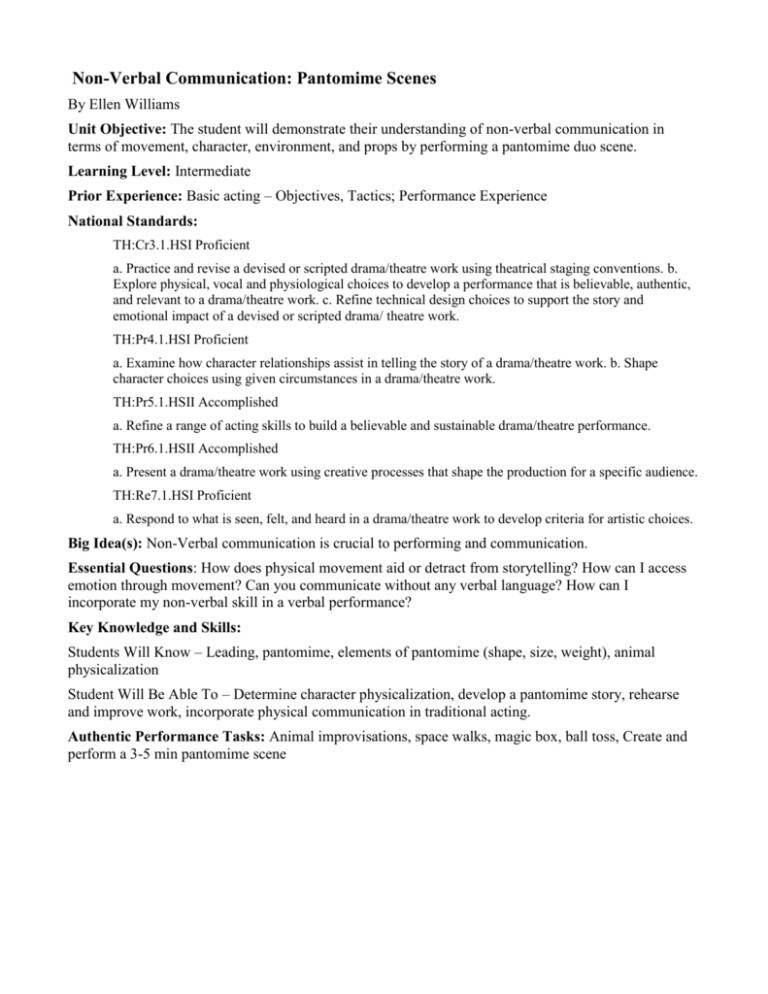
Non-Verbal Communication: Pantomime Scenes By Ellen Williams Unit Objective: The student will demonstrate their understanding of non-verbal communication in terms of movement, character, environment, and props by performing a pantomime duo scene. Learning Level: Intermediate Prior Experience: Basic acting – Objectives, Tactics; Performance Experience National Standards: TH:Cr3.1.HSI Proficient a. Practice and revise a devised or scripted drama/theatre work using theatrical staging conventions. b. Explore physical, vocal and physiological choices to develop a performance that is believable, authentic, and relevant to a drama/theatre work. c. Refine technical design choices to support the story and emotional impact of a devised or scripted drama/ theatre work. TH:Pr4.1.HSI Proficient a. Examine how character relationships assist in telling the story of a drama/theatre work. b. Shape character choices using given circumstances in a drama/theatre work. TH:Pr5.1.HSII Accomplished a. Refine a range of acting skills to build a believable and sustainable drama/theatre performance. TH:Pr6.1.HSII Accomplished a. Present a drama/theatre work using creative processes that shape the production for a specific audience. TH:Re7.1.HSI Proficient a. Respond to what is seen, felt, and heard in a drama/theatre work to develop criteria for artistic choices. Big Idea(s): Non-Verbal communication is crucial to performing and communication. Essential Questions: How does physical movement aid or detract from storytelling? How can I access emotion through movement? Can you communicate without any verbal language? How can I incorporate my non-verbal skill in a verbal performance? Key Knowledge and Skills: Students Will Know – Leading, pantomime, elements of pantomime (shape, size, weight), animal physicalization Student Will Be Able To – Determine character physicalization, develop a pantomime story, rehearse and improve work, incorporate physical communication in traditional acting. Authentic Performance Tasks: Animal improvisations, space walks, magic box, ball toss, Create and perform a 3-5 min pantomime scene Lesson 1: Observing others Movement Objective - Students will demonstrate their ability to observe and mimic movement by successfully mirroring another student’s movement and recognize how the already use movement to communicate. Materials Needed: Movement observation sheets for each student, writing utensils, Hook (15-20 min) – other students are moving and how they move in response to different activities they are doing. You need to write down what you are observing. You can work with a partner if you would like but you need to make sure that you are not being distracting in anyway. This includes being too loud or creepy in you observations. m. Activity 1 (10-15 min) – understand what was happening even though you couldn’t hear what was being said necessarily? Show me some of the things you saw. Activity 2 (15-20 min) – basket.” Continue the game but change who is Simon periodically and have a student lead. of movement not just typical “touch you head, sit down, etc.” being Simon or a follower? Why? Activity 3 (10-15 min) – vity called mirror. They need to choose someone to be the leader so it is clear who you are following. Show them with a volunteer what this should look like. Conclusion (5-10 min) – would we want to do this exercise? How can we learn from this in terms of acting? movements in different settings other than the gym. You will need to turn this in so make sure you write it down. Name: __________________________________ Observations You are on a mission, should you choose to accept it, to observe how the body moves. The categories on this sheet are to start you thinking about specific body movements. You may observe one person for each category or the same one the whole time. Make some notes on what you see. You will be turning this in. Walk: Run: Posture and Stance: Arm Use: Hand Use: Facial Expressions: Lesson 2: Physical Exploration Lesson Objective – Students will be able to explore their bodies movement in a purposeful way by participating in space walks and reflecting on what they learned in an informal journaling activity. Materials Needed – Open space (maybe even stage?), speakers, music (“She’s on Fire” – Train, “Once Upon a December” – Anastasia, “Bombay Dreams” – Bombay Dreams, “D’amour l’ardente Flamme”Fauste, “Top of the World” – Carpenters) Hook (5 min) – Have students take out their homework. Then instruct the students to stack up their chairs, put down the tables, and stack the tables in the closet and the chairs on the edges of the room. Then they need to find a partner. Teaching Presentation – Instruction (5-10 min) – Explain that they need to discuss what movement they observed, what meaning they derived from it, and what they learned from it with their partner. After it seems that the partnerships are winding down in discussion ask the class to share some of what they discussed, what they found interesting, etc. Make sure and apply what they observed/learned to non-verbal communication in acting. Transition (2 min) – We are going to talk about about different ways that we can use our bodies to manipulate what we are communicating and we are going to experiment with that just a little bit. Turn off one set of the lights. We are going to do what is called a spacewalk, this is a SILENT activity, if you are not silent you will return to your seat and will not get to do the activity. Why do you think that we need to be quite in this activity? What purpose would that serve? This is meant to get them to realize that when we are working on isolating our physical communication it is helpful to be silent so we can really focus. Guided Practice (10-15 min) – I want you to just start walking around the space, focus on walking throughout the entire room, and don’t react to those around you aside from avoiding walking into them (called a soft focus), focus on your own movement, your own walking. Make sure you are breathing and just walk, explore the whole space. Take note of how fast you are walking, how big your steps are, and how much your arms are swinging. Where are you leading from? By that I mean does your head lead the way like so? Does your chest, hips, feet? A combination of both? Walk around and focus on how you are leading. Now I want you to choose one of the other “leaders” I listed that you don’t do naturally. Head, chest, hips, feet. Does this change the way you feel? Does this change the speed you walk at? Does this change how your arms sway? Do you take longer or shorter steps not that you have changed? Repeat this 4 times so that everyone tries each one. On the last round ask them continue walking with the leader they chose but to notice those around them. What do they think about the people leading with their head? Chest? Hips? Feet? What kind of person are they, what do they like to do? What do they think of themselves? That do they think of others. Discussion/Checking for Understanding (5 min) – Take a seat where you are. Now you get to talk by raising your hand, tell me what you observed about your peers as they were walking around. Please state what they were leading with (or what you think they were leading with) and your impressions. What kind of person are they, what do they like to do? What do they think of themselves? That do they think of others. How can this knowledge help us as actors or performers? Guided Practice (10-15 min) - I want you to just start walking around the space, focus on walking throughout the entire room, and don’t react to those around you aside from avoiding walking into them (called a soft focus), focus on your own movement, your own walking. Make sure you are breathing and just walk, explore the whole space. Take note of how fast you are walking, how big your steps are, and how much your arms are swinging. I am now going to play some music and I want you to “walk” in response to the music. First play a fast tempo song- “She’s on Fire” by Train. When they start to stop exploring ask them to try something new, exaggerate their movement, “do” more. Notice where you are leading in response to this music. Does it change or not? Then play a slow tempo song, “Once Upon a December” from Anastasia and/or “D’amour L’ardente Flamme” – French Opera Arias. When they start to stop exploring ask them to try something new, exaggerate their movement, “do” more. Notice where you are leading in response to this music. Does it change or not? Then play a stylized song “Bombay Dreams” from Bombay Dreams and/or ”Top of the World” by the Carpenters. When they start to stop exploring ask them to try something new, exaggerate their movement, “do” more. Notice where you are leading in response to this music. Does it change or not? Discussion/Checking for Understanding (5 min) – Everyone take a seat on the floor where are you are. What did you learn about movement through this activity? How do you change your movement based on environment? Feelings? Etc. Why do you think where you lead changed in response from one song to the next? What characters were you maybe portraying for each song? Closure (5 min) – I want you to remember all that we have learned today and be MORE aware of your own movement. This weekend you are to be thinking about your movement. How do you move differently when you are tired, when you are frustrated, when you are angry, etc.? We will take a moment to respond to these observations next week so be thinking. Lesson 3: Emotion and Character Unit Objective: Students will be able to portray emotion and character by participating in space walks and animal improvisations. Materials Needed: Empty space Hook: Have the classroom cleared as the students enter so that there is plenty of empty space. Activity 1 (25-30 min) - Emotional Physicalization Activity - Can someone sum up what we talked about last time? Why are we focusing on this? How does it apply to “traditional theatre?” I am trying to give you a toolbox for how you can incorporate your movement into your acting in a more specific and clear way. Today we again are going to be focusing on movement and specifically emotions and movement as well as animal movement. - This time we are going to split the class up and take turns participating. I want to make it clear that this is NOT a performance, we are not performing for the other group but all learning together. You are not to pose “for” the other half of the class but for yourself. As an audience member you also need to be learning so you will take notes that can help you participate when it is your turn. My first group will give the second group advice to help them better learn and explore. - Again, this is a silent activity in that there should be no talking and really no interacting with others. Same consequences apply for not being focused. Why do you think I am wanting you to be silent during these activities? Really make sure they discover that we are focusing on movement and how we communicate non-verbally and that requires silence so we can really focus in. We need to push the tables to clear space again for our activity today. This time we are going to fold the tables down and stack them on top of each other as well as the chairs. - We are going to start by once again walking throughout the space. Keeping our soft focus and just moving throughout the space. Notice your breathing, how you are walking, long steps, short steps? How does your emotion effect how you are moving? How do you feel today? Tired, excited, nervous. Let that show in how you are walking. Really take note of what you are feeling internally and notice how that effects your movement. - Now I am going to call out an emotion. Then I am going to say “1-2-3 Freeze” at which point you are going to freeze in a position that shows that emotion. So let’s try it. Sad “1-2-3 Freeze.” Okay I am going to do that emotion again but I want you to try a different/less typical way of showing that emotion, sad. “1-2-3 Freeze.” o Happy o Angry o Entertained o Bored o Curious o Confused - Make sure and ask them to exaggerate, try something new. After group 1 has finished have them give advice to group 2 AND then switch and do the whole activity again. Activity 2 (25-30 min) Animalization Physical Activity - The whole class is going to participate together in this activity. You will have less space but if you stay focused on what you are doing you will be fine. You really need to show great focus and maturity in this activity. Why do you think it is important that we aren’t laughing, talking with our friends, etc? We then lose focus and start to feel that we can’t explore because we are too conscious of those around us, watching us, instead of exploring we begin to perform. We are going to discover how animal’s physical movements can really help us to more as actors. I want you to think of one of your favorite characters, they can be from a book, a play, a video game, a movie, etc. Raise your hand once you have chosen your character. - Now I want you to determine an animal that you feel this character could “TRANSITION” to. So if I were picking Severus Snape from Harry Potter I would say he is snake like. Does that make sense? Now once again when you have picked an animal raise your hand. Don’t overthink it, just choose and animal. - I am going to say “goodnight animals” and you will all lay down to sleep, then I will say “Good morning animals” and you will all wake up as if you were that animal. If I were a cat I would begin stretching, start pawing at the floor, licking my paw, etc. I will then continue to narrate your “day” and you will respond as that animal would physically. - As you narrate make sure and encourage them to really try new things, discover. - “Animals, time to eat” - “Animals, time to play” - “Animals, time to clean your room.” - “Animals, time to take a bath.” - “Animals, time to find food.” - “Animals, time for bed.” - Now I am going to say, “Students wake up” and you are going to wake up as humans but using your animal to inspire your character. Maybe you still slither out of bed like you did with the snake but in a more human manner, etc. - When complete turn on the lights and tell the students they need to write one thing on the board that they learned from this activity, about themselves? About others? About acting? About storytelling? About movement? Etc. Then go through and discuss what was written. Conclusion: We are going to continue what we have learned by doing pantomime. Like we have done in the past few days we are going to hone in so specifically on movement that we are going to eliminate verbal communication completely and focus entirely on the physical. Please don’t lose track of these tools we have discovered in how we lead, how our environment changes us, how we can show emotion physically, and how we can use animals to inspire characterization. Lesson 4: Pantomime Lesson Objective: Students will display and understanding of pantomime by playing the magic box game. Materials Needed: Magic Box Signs Hook (30-45 min): - Clear the classroom of all chairs and tables. - Sitting silently on the floor with the sign up saying sit in a circle. - Play the magic box game. See signs for rules. On a full sheet of paper, have each of the following sentences typed/written to show to the class to instruct them on what to do with the Magic Box. The papers can be even more effective if your facial expressions and gestures match what the papers say. In front of me there is a box. It is a MAGIC BOX. It is magic because it's invisible. It is also magic because it can hold anything inside of it. (Think Mary Poppins!) Each of us gets to choose something from the box… and show the rest of the class what it is. Do not talk or make noise while you do so. I'll go first. Activity 1 (10-15 min): - Did you enjoy that? What was hard? What was easy? - What made for a good magic box? What helped you know what was being pulled out? – Make a list. Try and aim for the following: o Specificity o Clear o Slow o Size o Shape o Weight - Those last three are what we are going to refer to as elements of pantomime. When we show size, shape, and weight it becomes clear what object we are holding. Let’s practice this. Activity 2 (25-30 min): - Get into a new circle. This is a simple game where we are going to pass each other a ball. Now when you catch and throw a ball it can be any ball you would like, you just need to make sure that we can see what that ball is, for example if I am going to throw you a bowling ball it has a different shape, size, and weight then say a football. I will start…pass someone a ball making sure you show shape, size, and weight by how you prepare for the throw and finally throw it. - Encourage the students to try different balls, maybe even try different things you can throw, not necessarily a ball. Side coach by telling them to be more specific, exaggerate, slow down you movements. - Make sure everyone gets a chance to throw an object. Conclusion: We are going to be doing our own pantomimes in groups and next time I will have you divided up and explain the assignment but be thinking about how we used our bodies to tell a story. Lesson 5 – Pantomime Scenes Objective: Students will demonstrate their understanding of pantomime stories by creating a pantomime storyline for two performers. Materials Needed: Copies of Pantomime Rubric, Pantomime improv Hook (15-20 min): Have a couple of students come to the front of the class to perform a short pantomime improvisations (see attached scenarios). After they have read through the scenarios have them improvise reminding them that they are not to use any sound or vocals. After the performance ask the class what did you observe? What was happening in the scene? What do you think the characters wanted? What did they communicate through their body language? Activity 1 (15-20 min) Transition – Talk with the class about how a simple activity or situation can be engaging to watch. Reinforce the idea with the students that sometimes action comes about because of how a person is. Encourage the students to always create interesting, engaging, and unusual characters that have a need to fulfill in their performance work. Instruction – Introduce the basics of creating a good pantomime storyline: - KISS (Keep It Simple Stupid) – make sure it is easy to understand and not cluttered with excess movement and gestures; audiences need all the clues they can get to understand what you're doing - Tell a complete story – have a beginning (initial situation), middle (complications, obstacles, or problems that get in the way), and an end (some kind of solution to the problem) - Be fantastic – both in the "good performance" aspect and the "not reality" aspect; pantomimes do not have to follow regular rules and should be larger than life at all times. Activity 2 (10-15 min) Modeling – Either by yourself or together as a class, create a rough outline of a story that follows the storyline basics just taught. Some examples could include "Dinner at Aunt Bertha's" (a reviled relative with nasty food), "The Bionic Ant" (man versus insect for a piece of popcorn that was dropped on the sidewalk), "Window Washer vs. Bird" (a flock of birds deposit their goods on a clean skyscraper window), "Wild West Shootout" (a cowboy gets into a fight in a saloon and takes it outside), "The Pop Machine" (an eager teenager wants a can of pop so bad that he's willing to climb inside the vending machine), "The Best Bubble Ever" (a chewing gum incident gone so big that the chewer is trapped inside the bubble and can't escape). Activity 3 (35-40 min): Group Work – Divide students up into pairs previously assigned. Assign each pair to create – and write down – a pantomime story that involves two people. - Title – make it interesting and yet give a clue into the pantomime character or story - Duo – meaning two people must perform it and have equal opportunity to be seen - Time – three to four minutes Storyline – use the basics discussed in class - Simple – be sure each partner has the chance to demonstrate all three qualities of pantomime - Written outline: characters (one sentence description and relationship), place (setting/situation), story outline (including at least four conflicts) Guided Practice – Have students write their outline and begin to rehearse their pantomime on its feet. Duo-Improvisation Scenarios 1. Awaiting a friend to come and play chess, you prepare the chessboard. When your friend arrives both begin to play. The game is close and your friend loses. He accuses you of cheating and there is a heated argument. He walks out angrily. 2. You enter a shoe store and sit to be waited on. You describe to the clerk the type of shoe you want. He brings three pairs. You try on two pairs and decide to take the first pair. The clerk thinks the second pair looks better and attempts to change your mind. The scene ends with you buying both pairs. 3. You are reading a very humorous book in a public library. You laugh aloud. The librarian reminds you that you must maintain silence. You are embarrassed and apologize, but return to your reading. Again you laugh aloud and the librarian rebukes you. You move to another seat and resume reading. This time when you laugh, the librarian asks you to leave. You persuade her to read from your book. She does, and breaks into loud laughter. 4. You stealthily enter the kitchen. You place a step stool near the cupboard and climb to where you can reach the cake box on the top shelf. You get it down and cut yourself a slice of freshly baked cake. Your sister enters. When she sees what you have done, she is furious since the cake was for a cooked food sale. You make a flippant remark, and she grabs the nearest implement and chases you out the door. She returns feeling discouraged and begins to eat the piece of cake you cut. Lesson 6 – Pantomime Exploration Lesson Objective: Students will demonstrate and understanding of non-verbal communication elements by exploring character, environment, and emotion in a space-walk. Materials Needed: board, markers, Hook (20-25 min): We are going to do a little warm-up pantomime game to get us thinking about what we have learned about pantomime and physical communication. Ask for 4 volunteers. One eye-witness and three detectives. Detectives are sent out of the room. The class chooses three things about a murder (VICTIM’S OCCUPATION, LOCATION OF THE MURDER, AND THE WEAPON) that has taken place (the one that the eye witness saw). Eye-witness must pantomime these things to the first detective. when he thinks he gets it, he has to say BING and do a hand motion above their head (like a lightbulb has gone off) (no guesses out loud, no asking for hints, the eye-witness just has to keep trying different ways until the detective thinks they get it). Once he has said BING to all three things, HE has to act it out for the next detective. Same rules apply. It’s like the telephone game mixed with pantomime. After all three detectives have been told what happened, the last one tells the class what they think happened in an official sounding police report. An example could be: batman, in a donut shop, killed by poison. So there is no talking at all, except for the BING that the detective said for each clue. Go ahead and write down Occupation, Location, and Weapon on the board to remind the participants the different categories they are pantomiming/guessing. Have the volunteers choose people to replace them so that a fair amount of students get to participate. - What did you learn doing that activity that can help you as we work on pantomime today? What helped you to understand what they were trying to communicate? Activity 1 (40-45 min): We now need to push chairs and tables aside. With your partner choose who will be #1 and who will be #2. #2 partners need to sit on the floor along the walls of the room. You are going to be observing what you see your partner discovering and others as well. #1 partners, you are not meant to be performing for your partner but it will be helpful for them to be able to see what you are exploring. As we have discussed in other lessons this is a silent activity. #1 partners start walking around the room as you normally would, notice how fast or slow you are walking, pay attention to breath, where you naturally lead, etc. Now I want you to start thinking about your character in the pantomime story you have created. Now change how you walk based on this character. You may not have a clear idea of your character yet but use this time to really explore what that character could be like. Do they walk fast or slow? Big steps or small? Walk in straight lines or curves? Do they lead with their head, chest, hips, or feet? If you don’t like what you are trying, try something else. Really see how detailed you can get. Now I want you to continue walking as your character as if you were walking from a class to another class, now if you were walking outside in the cold. How does your character change their movement when the environment changes. Now think about the location/environment your scene is set in, how does your character move in that environment? Really explore this environment, what things do you see in it? What is the temperature like? Light? How does you character discover the space around him. Continue walking in the environment as your character but now I want you to try a possible emotion your character would be feeling in the scene you are portraying. How does you character show that through movement? How does it change from one emotion to another? Now try another potential emotion, how can you portray that without any sound? Do you speed up your movement, slow down? Do you change how you lead? Does your posture change? Now get together with your partner and discuss what your experience was like. What did you like that you did? What didn’t you like? What do you think you want to keep and what do you want to leave? What did your partner like in observing? What worked well? What didn’t? Now do the same activity with partner #2 and allow for discussion. Activity 2/ Conclusion (20-25 min): You are now going to have the opportunity to work with your partner in solidifying your scene. Really pay attention to those discoveries that you made and incorporate them into your pantomime. Make sure that you are paying attention to the different objects you will be using as well because we are going to work on those next time. Lesson 7 – Pantomime Objects Lesson Objective – Student will demonstrate their understanding of pantomiming objects by playing the magic box with specific objects they use in their pantomime scene. Materials Needed – Markers for each student, white board, grading rubric for each student Hook (25-30 min) – I want you guys to take a marker and write everything you can think of that we have learned about pantomime. What it is? What elements does it contain? What makes a good pantomime? What is important in a pantomime? Etc. Once everyone has had the opportunity to write go through and touch on each of the things written. Then circle what hopefully has shown up on the board as size, shape, and weight. Activity 1 (25-30 min) – Last class we focused on our environment, character, and emotion in terms of our pantomime scenes. We are going to now add onto that the objects that you will be pantomiming, a key aspect of pantomime. Split the class in two and have them get into two circles. We are going to play magic box again but this time you have to take out an object that you will be using in your scene. As observers you need to raise your hand when you understand what the object is. You must continue to pantomime until everyone in your group raises their hands. That means you will need to be more specific about the weight, the size, and the shape. How you hold it, how you use it, etc. When both groups have gone ask the class as a whole what that experience was like? If people struggled to know what the object was how did you finally get them to understand? How can we incorporate what we have learned into our pantomime scenes? Pass out the grading rubric (listed below; not in handout formatting). Really quickly go over the rubric in detail, reminding them of the importance of character, emotion, size, shape, weight, as well as other elements on the rubric. These earlier aspects will help you achieve the rubric. Activity 2 (45-50min) – You will now have the rest of the time to work on your pantomime scene. Don’t forget the work that we did last time and don’t forget to add in the work we did this time. Try and go through the rubric and see how you think you would score if you performed today. Pantomime Feedback Sheets Movement (weight, size, shape) - /10 Specificity – /10 Continuity - /10 Clarity - /10 Storyline – /5 Characterization - /5 Total /50 Lesson 8 – Rehearsal Lesson Objective: Students will demonstrate successful rehearsing skills by completing a rehearsal bingo board. Materials Needed: stickers, bingo boards for each student (not included) Hook: Place a bingo board and stickers on each student’s desk. Activity 1 (55-69 min): As you can see you are going to be playing a little rehearsal bingo. Go through and explain what each square means so that they understand. Tell them that they need to do each of these squares today in their rehearsal and submit it to me at the end of class with their names on it. This is meant to help focus your rehearsal time and make it much more efficient. You will be performing next class period so now is the time to get your pantomime polished. As they rehearse make sure that you are going around, offering feedback, reminders, answering questions, and keeping everyone on task. Conclusion: On the board write the order of the performances so that it is clear up front who is going when. Inform them that their performances may go over two days but they should all be ready to perform next time in case there is time. Lesson 9 – Performance Lesson Objective: Students will display understanding of non-verbal communication by performing their duo improvisation scenes. Materials Needed: Rubrics for each pair (not included in handout formatting), timer Hook (5-8 min): Give students time to touch base with their partners and warm up by running through their scene. After have each student perform according to the order. Make sure and write feedback on the rubric so that they have a thorough understanding of how they did and why.
